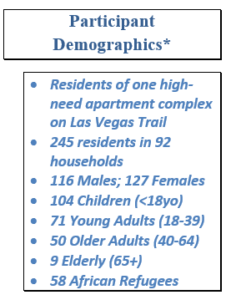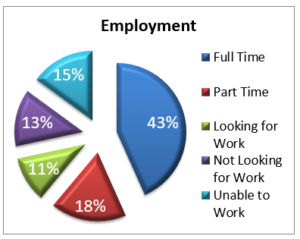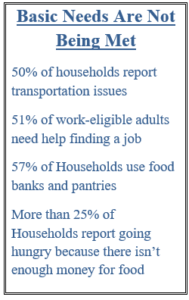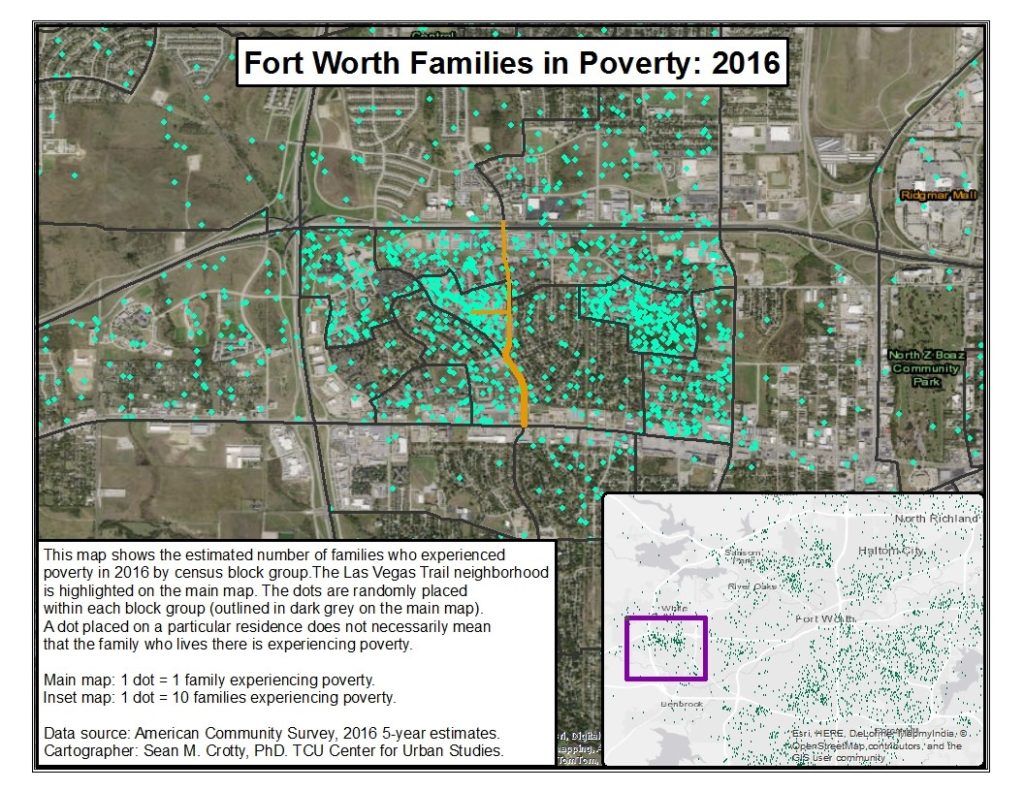A Deficit of Care: Needs Assessment in the Las Vegas Trail Community of Fort Worth, Texas
April 19, 2018
The Leveraging Project: Executive Summary: April 2018
Brie Diamond, Ph.D. and Sean Crotty, Ph.D., TCU Center for Urban Studies
Purpose
The Leveraging Project is a targeted social service intervention intended to help meet the basic needs of underprivileged communities in Fort Worth. It represents collaboration between TCU’s Center for Urban Studies, FWPD, United Way, JPS Hospital, MHMR, Tarrant Area Food Bank, Fort Worth Neighborhood Services, and Workforce Solutions. The goal is to provide targeted social service provisions in order to stabilize families and thereby reduce the need-based causes of crime and disorder in the community.
Initial Participant Community
It is our goal to eventually implement the Leveraging Project in communities throughout the greater Fort Worth area. The first location selected for the project is an apartment complex located in the Las Vegas Trail neighborhood in west Fort Worth. This community was selected based on several criteria. First, the neighborhood experiences disproportionately high crime rates and therefore has a strong potential for crime rate reduction through targeted social service implementation. Second, the specific apartment complex we surveyed was very supportive of the project and provided rent-credit incentives for residents’ participation. Third, the neighborhood includes approximately 32 apartment complexes whose residents have similar characteristics in terms of household income, un/under-employment, and healthcare needs. Improved access to services for our participant community can and should also positively impact residents in nearby apartment communities. Finally, the Las Vegas Trail area is somewhat notable in the block-to-block difference in incidence of poverty. As shown in Figure 1, the number of families experiencing poverty varies considerably from one census block group to another, so the neighborhood does not fit traditional definitions of impoverished areas. Islands of poverty exist adjacent to relative affluence—sometimes directly across the street.
Implementation
The primary innovation of the Leveraging Project is to improve the efficiency of need identification and service enrollment. Participants are only required to complete a single needs assessment survey, which is then used to identify potential clients for each of the partner agencies based on the specific needs of each family or individual. The needs assessment survey includes questions related to age, educational attainment, employment status, income, physical and mental health concerns, healthcare access, hunger/food availability, and transportation challenges.
Executive Summary: Initial Results
The following information concerns 245 residents from nearly 100 households in a single apartment complex on Las Vegas Trail. Forty two percent of these residents are children under the age of 18 and one quarter are adults over the age of 40. Fifty-eight refugees from various African nations are also represented in these data.
Top Concerns: Food and Transportation
The level of need in these households is alarming. The median monthly- household income is $1099 with many households reporting an income below $500. Thirty percent of households reported food access to be their most pressing need. This included simply being able to afford food as well as the need for closer food pantries. Many families remarked that WestAid was too far for them to walk and indicated a desire for a more frequent mobile food pantry (currently, this area is visited one Saturday per month by a mobile unit). WestAid is a 3 mile walk round trip from this complex and Western Hills UMC’s food pantry (available Tuesday & Thursday mornings) is a 1 mile round trip walk. Finally, one quarter of all households reported regularly going hungry because they couldn’t afford food.
Another primary need in this community is transportation. Twenty four percent of households identify transportation issues as their most pressing need. Many residents report having unreliable transportation that impedes their ability to look for jobs, get to their job, or obtain services in other parts of town. A common issue was the lack of efficient public transportation. One resident explained how his total commute to work near DFW airport is over two hours long with multiple changes among the train and bus systems. With the recent fare changes, many residents also reported not being able to afford to ride the bus anymore. One disabled veteran explained that since her caregiver can no longer ride for free they are not able to take the bus to the grocery store or to VA appointments. Another family of four stated that, “even if he (the father) could get a job, we couldn’t afford to get him there.” Transportation problems were a common complaint among residents—one that has substantial impact on their employment, health, and hunger.
Employment
Employment was the third most commonly reported need. Less than half of adults in this community are employed full time. Looking only at those adults who are either working or looking for work (excluding adults unable to work or not looking for work), only sixty percent are employed on a full-time basis.
Full time employment is not the whole story, though. More than half of work-eligible adults report needing help finding a job. Even among those employed full-time, many explain that they cannot support their household with their current wages and that their hours are inconsistent. Several full-time workers requested help finding a better paying job and a number of families appear to be on the verge of homelessness due to their marginal income.
 Invisible Needs: Mental Health
Invisible Needs: Mental Health
Beyond the basic needs of food, transportation, and employment, a sizeable proportion of households report recent experiences of serious loss in the past year. Roughly half of all households are dealing with the death of a close relative, serious car accidents, loss of employment, homelessness, or declining health. Each of these concerns can trigger or exacerbate mental health issues that should be addressed through counseling. Some residents are receiving such services through MHMR, but many have not sought help in recovering from these losses.
Further, 20% of parents in this complex expressed concern about their children’s behavior at home or at school. ADHD, anger and oppositional defiance, and learning disabilities were common complaints among parents. Other parents reported struggling to help their autistic children receive services and thrive in school while others were caring for children suffering from PTSD. Again, many parents had sought counseling services through MHMR, but others were not receiving professional assistance for these issues.
Next Steps: Linking Services
The purpose of the Leveraging Project is to identify community needs and better connect residents to relevant services. Service partners have received contact information for residents qualifying for their services and are in the process of connecting with these households. To the extent possible, these partners will travel to the community rather than asking residents to visit their offices.
Many of the needs identified in this survey can be addressed through existing services. Others present more complex issues that our city needs to consider. Public transportation in this area, for example, is too expensive for many residents and is too time consuming to be reliable. Many respondents specifically referenced a recent price change for a daily ride pass to $5 that put normal public transit beyond their affordability threshold. Cost was not the only challenge. Consider the case of our respondent who travels ~5 hours per day for his job near the DFW airport. Combined with an 8-hour shift, that means the respondent spends 13 hours per day on work-related activities. On one level, we might applaud this sort of dedication. Yet, his children attend a school for which test scores are low and leading thinkers on educational success suggest that parental involvement in their child’s education is critical to improved academic achievement (Fan & Chen, 2001; Jeynes, 2003; 2007). It is no mystery why this particular respondent fails to attend parent-teacher night or make sure homework is completed; he’s on the 3rd bus of his commute still trying to get home. Affordable childcare solutions also represent an opportunity to improve the quality of life for residents. What may be considered a low cost option for many, Clayton YES’s after school program within FWISD, is still financially out of reach for an overwhelming number of these parents.

Finally, it is important to keep in mind that this report documents the situations for roughly half of the residents of a single apartment complex on Las Vegas Trail. This area of Fort Worth—including Las Vegas Trail, Normandale Street, and Calmont Avenue—is home to 32 apartment complexes; virtually all of which are low-income housing. Assuming the sample apartment complex to be of an average size (roughly 600 residents) for the area, the greater Las Vegas Trail area is easily home to 20,000 people residing in multifamily dwellings. Extrapolating the findings to this greater population highlights the intense, concentrated need in west Fort Worth. Should this apartment complex be representative of the complexes in the area, this means thousands of households relying on food banks, having transportation problems disrupt their livelihood, and regularly going hungry. Looking forward, the concentrated poverty in this area threatens to shape the lives of hundreds of children growing up on Las Vegas Trail.
Cataloging how 20,000 people became concentrated into a small area on the outskirts of town is beyond the purposes of this summary. When considering how to disrupt this phenomenon, though, it is important to consider the positive impact of creating economically diverse housing options in close proximity to one another (Kleinhans, 2004). This helps to increase opportunity and access for all citizens—especially those who need them most.
References
Fan, X. & Chen, M. (2001). Parental involvement and students’ academic achievement: A meta-analysis. Educational Psychological Review, 13(1), 1-22.
Jeynes, W. H. (2003). A meta-analysis: The effects of parental involvement on minority children’s academic achievement. Education and Urban Society, 35(2), 202-218.
Jeynes, W. H. (2007). The relationship between parental involvement and urban secondary school student academic achievement. Urban Education, 42(1), 82-110.
Kleinhans, R. (2004). Social implications of housing diversification in urban renewal: A review of recent literature. Journal of Housing and the Built Environment, 19(4), 367-390.
